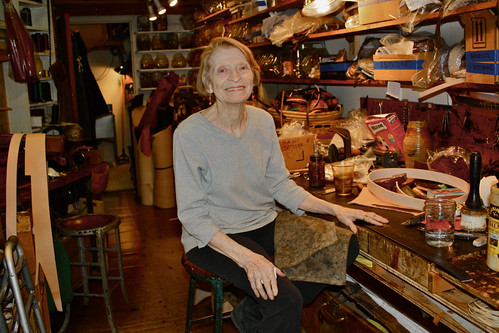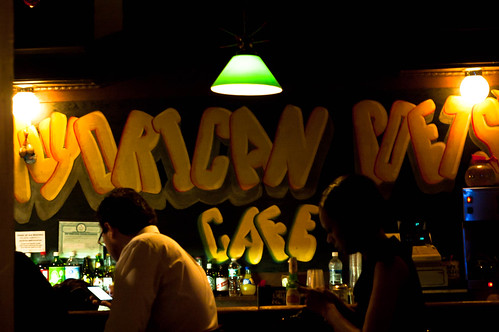 Suzanne RozdebaBarbara Shaum in her workspace on East 4th Street.
Suzanne RozdebaBarbara Shaum in her workspace on East 4th Street.When you’ve been in business as a ‘solopreneur’ since 1962, you find you’re known for a few things, and you pay no mind about taking your time to relay all the details to anyone within earshot. For Barbara Shaum, 80-something, the legend behind the institution that is Barbara Shaum Ltd. on 60 East 4th Street, that means noting she was the very first woman officially to enter the male-only McSorley’s Bar, and that she hand-makes what fashion icons view to be some of the very best leather sandals and belts in the city. These days, it is rarity to enter a shop where there is a craftswoman who cobbles the very item you plan to slip on, right there in the store. Ms. Shaum, but she doesn’t have plans to retire either. Too many people are depending on her to outfit their feet.
Q.
How did you make your way into this business?
A.
I was doing wholesale and living in a loft on West Broadway. I was working for a wonderful sandal-maker who taught me so much of what I know. This was back in the 50s. Then I went on my own in 1962, opening up a shop on 7th Street between Bowery and Second Avenue.
Q.
Right next to McSorleys! That must have been interesting.
A.
Absolutely. It was for men only until 1970 when the Civil Rights Bill was passed and they could no long discriminate against women patronizing their establishment. I was the first woman in there and that’s the kind of person I am.
Q.
Was there a benefit to being in the location next to such a legendary place?
A.
I sell to men and women and the bar was enormously popular. It was the 60s so there were hippies wearing a lot of belts and sandals so I was making a lot of sandals and belts. That was a good time for me. Lots of off-beat people with style.
Q.
People weren’t really worrying about making their rent so much then were they?
A.
In those days things were not so much focused on real estate and money and that sort of thing. My rent was very low. It was $75 a month for quite a large place. I had a front part and a back part where I put up a wall and I lived back there. I also had a backyard and I’d have these big backyard barbecues with like 75 people coming by. Read more…
![P4180073[1]](http://farm6.static.flickr.com/5302/5634942718_c87c354563.jpg) Jesse Fish
Jesse FishThe East Village has historically been visited by and home to a diverse and eclectic variety of artists, musicians and writers. More than 50 years ago it was the domicile of the late drug-ingesting, drink-swilling gonzo journalist Hunter S. Thompson. In the winter of 1959 the 22-year-old Thompson listed his address as 69 East Fourth Street, a residence he shared with a friend.
According to Thompson’s letters in “The Proud Highway” (1997), the native Kentuckian befriended a number of Louisville expatriates while living in downtown Manhattan. Most of “them move in different circles,” he wrote to the editor of a hometown paper, ”and all of them have their own reasons for leaving.” Thompson wrote explained that his story would be “a single shot (Louisville Expatriates in New York) or a series of contrasting interviews.” New York City was not easy for The Good Doctor at this time and he had moved in and out of the area on occasion. While living in Greenwich Village a year before, Thompson wrote an unsolicited letter to a newspaper in British Columbia stating that he would be willing to “work 25 hours a day if necessary, live on any reasonable salary, and don’t give a black damn for job security, office politics, or adverse public relations.”
The erratic and spontaneous Thompson, who once stated that he had “no taste for either poverty or honest labor, so writing is the only recourse left for me,” bounced through a variety of neighborhoods and writing jobs in Manhattan during the late 1950’s and throughout the 1960’s. During this time he also briefly studied short story writing at Columbia University and wrote a novel, “Prince Jellyfish,” which remains unpublished. The work has been described as “an autobiographical novel about a boy from Louisville, going to the big city and struggling against the dunces to make his way.”
Despite his initial grappling as a young writer in the city, Thompson always had time and money for a few brews and one of his favorite haunts, McSorley’s Old Ale House, is within stumbling distance of the East Fourth Street address. Additionally, the Hell’s Angels New York headquarters are located near this residence on 77 East Third Street. This is interesting to note because Thompson’s first published book, “Hell’s Angels: The Strange and Terrible Saga of the Outlaw Motorcycle Gangs” (1966), was a non-fiction publication that Thompson penned while riding with the notorious biking gang in the early 1960’s. It is not known if Thompson ever visited their East Village hangout before the 1966 publication of the book, but the thought of a boozed up and downtrodden young Thompson asleep on the group’s bench outside does not seem incredibly far-fetched.
 Helen Zhang Now 81, Barbara Shaum has been making sandals at her East Village shop for five decades.
Helen Zhang Now 81, Barbara Shaum has been making sandals at her East Village shop for five decades.Summer has faded into memory and trips to warm climes are still months off, so having just ended her busiest season, the celebrated sandal maker Barbara Shaum can take some time to sit and chat.
At age 81, Ms. Shaum, who seems to call everyone “darling,” has been fashioning custom-made leather sandals for the last 50 years in her store at 60 East Fourth Street. She arrived in New York in 1951 from a small town in central Pennsylvania with a dollar in her pocket and not a clue of what she wanted to do, except that she wanted to work with her hands.
Read more…
 Hannah Thonet Founded in 1973, the Nuyorican Poets Cafe regularly features spoken word events and open mic nights
Hannah Thonet Founded in 1973, the Nuyorican Poets Cafe regularly features spoken word events and open mic nightsThe East Village has long been considered a Mecca for poets and writers. From bars to old tenement buildings, the historic neighborhood is brimming with former haunts of longtime residents like Allen Ginsberg and W.H. Auden. The crisp weather and changing leaves makes fall the perfect season to wander through the area on a romantic tour. So here’s a roundup of iconic East Village literary landmarks – why should the West Village get all the glory?
Ginsberg Residences
206 East Seventh Street (between Avenues B and C)
170 East Second Street (between Avenues A and B)
Arguably the neighborhood’s most well-known scribe, poet Allen Ginsberg called several apartments home throughout the East Village, including one we recently told you was on the market. In addition to the 12th Street apartment, he lived at 206 East Seventh Street from 1952 to 1953 where fellow Beat poet, William S. Burroughs, was a frequent visitor. Another one of his apartments was at 170 East Second Street. Ginsberg and his longtime partner, Peter Orlovsky, also a poet, lived there from 1958 to 1961.
Read more…




![P4180073[1]](http://farm6.static.flickr.com/5302/5634942718_c87c354563.jpg)


